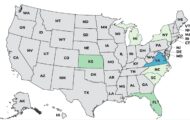A Salmonella Enteritidis outbreak in Canada has sickened at least 63 people in six provinces, but public health officials have not identified a source of the pathogen. Officials are sharing this information to inform consumers how to avoid Salmonella infections. There is another Salmonella outbreak in that country that has sickened more than 500 people. That outbreak is linked to frozen breaded raw chicken and other raw chicken products.

The case count by province is British Columbia (23), Alberta (10), Saskatchewan (8), Manitoba (10), Ontario (10), and Quebec (2). Illness onset dates range from November 2018 through March 2019. The patient age range is from 1 and 87 years. Eighteen people have been hospitalized because their illness is so serious. Two deaths have been reported, but officials have not yet determined whether the Salmonella infection was a contributing cause in these deaths.
Past Salmonella outbreaks have been linked to everything from raw chicken to eggs to frozen breaded chicken products, to raw sprouts and leafy greens. This pathogen can infect any food at any point along the processing and distribution chain.
The symptoms of a Salmonella infection include a fever, nausea, abdominal and stomach cramps, vomiting, and diarrhea that may be bloody. These symptoms usually start 12 to 72 hours after someone has eaten food contaminated with the bacteria. Most people recover after a few days or a week, but some become so ill, usually due to dehydration or sepsis, that they must be hospitalized.
To prevent Salmonella infections, it’s important to follow some food safety procedures. First, wash your hands well with soap and water after using the bathroom and before preparing food or eating. Never prepare food for others if you are sick. Don’t eat undercooked meats, poultry, fish, shellfish, or products made with eggs.
Always cook all perishable foods such as meats, poultry, fish, and eggs to a safe internal temperature depending on the food. Poultry, including ground poultry, should be cooked to 165°F. Ground meats, including ground beef and pork, should be cooked to 160°F. Use a digital food thermometer to make sure that the temperature is reached.
Microwave cooking of meats, poultry, fish, and eggs, including frozen breaded poultry products, should be avoided. This appliance can leave cold spots in the food and bacteria may survive the cooking process, making you sick.
Finally, avoid cross-contamination between raw meats and poultry and other foods. Don’t re-use plates, cutting boards, or utensils that were used on raw meats and poultry. Sanitize countertops, cutting boards, and utensils before and after preparing food.




